International scrutiny comes as Canada works toward new rules that could see release of treated water for first time
Author of the article: Meghan Potkins
Publishing date: Aug 26, 2022\
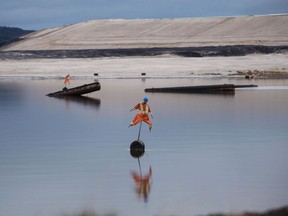
Scarecrows, used to deter birds from landing, stand in the Syncrude Canada Ltd.
tailings pond in the Athabasca Oil Sands near Fort McMurray, Alberta, in 2018.
PHOTO BY BEN NELMS/BLOOMBERG
t
When the Mikisew Cree First Nation grew tired of warning elected officials that the Peace-Athabasca Delta in northern Alberta was slowly drying up, they went international in a bid to find help.
That’s how a group of United Nations monitors came to be seated in a community hall in the remote community of Fort Chipewyan last weekend, going over the nation’s list of concerns for Wood Buffalo National Park, the site of one of the largest freshwater deltas in the world and and home to endangered whooping cranes and the continent’s largest wild bison populatio
“We just felt ignored, like our concerns were not being heard,” said Melody Lepine, Mikisew First Nation’s director of government and industry relations. “So we went international and UNESCO listened.”
This is the second mission to northern Alberta by UNESCO investigators since 2016. Monitors, who concluded their trip Friday, will try to determine whether Wood Buffalo National Park should be on the list of World Heritage Sites in Danger — an outcome the UN agency has suggested is likely, since Canada hasn’t made enough progress in addressing a number of threats to the Peace-Athabasca Delta, including the impact of oilsands tailings ponds on water quality.
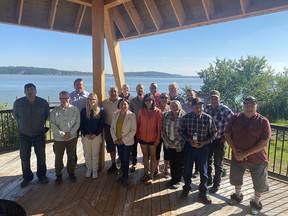
t
When the Mikisew Cree First Nation grew tired of warning elected officials that the Peace-Athabasca Delta in northern Alberta was slowly drying up, they went international in a bid to find help.
That’s how a group of United Nations monitors came to be seated in a community hall in the remote community of Fort Chipewyan last weekend, going over the nation’s list of concerns for Wood Buffalo National Park, the site of one of the largest freshwater deltas in the world and and home to endangered whooping cranes and the continent’s largest wild bison populatio
“We just felt ignored, like our concerns were not being heard,” said Melody Lepine, Mikisew First Nation’s director of government and industry relations. “So we went international and UNESCO listened.”
This is the second mission to northern Alberta by UNESCO investigators since 2016. Monitors, who concluded their trip Friday, will try to determine whether Wood Buffalo National Park should be on the list of World Heritage Sites in Danger — an outcome the UN agency has suggested is likely, since Canada hasn’t made enough progress in addressing a number of threats to the Peace-Athabasca Delta, including the impact of oilsands tailings ponds on water quality.

Representatives of the Mikisew Cree and UNESCO delegation earlier this week.
PHOTO BY SUPPLIED/COURTESY MELODY LEPINE
The international scrutiny comes as the federal and Alberta governments are working to develop new regulatory requirements that could enable the release of treated water from the oilsands mines for the first time since the sector’s inception.
For its part, the oilsands industry says wastewater used in the industry’s bitumen mining process that has been stored for decades in vast toxic ponds in northern Alberta can be treated and safely released back into the environment.

The international scrutiny comes as the federal and Alberta governments are working to develop new regulatory requirements that could enable the release of treated water from the oilsands mines for the first time since the sector’s inception.
For its part, the oilsands industry says wastewater used in the industry’s bitumen mining process that has been stored for decades in vast toxic ponds in northern Alberta can be treated and safely released back into the environment.

An oilsands tailings pond north of Fort McMurray, in 2011.
PHOTO BY TODD KOROL/REUTERS FILES
The sector has been working on plans for the reclamation of tailings sites — a process the industry says will require the release of wastewater into the Athabasca River. Unlike other mining and industrial operations in the country, oilsands operators have not been permitted to release treated water and volumes have been building for decades — now in the range of 1.4 trillion litres.
“We’re very much in alignment in wanting to protect the downstream environment and protect the Peace-Athabasca Delta and obviously, the Wood Buffalo National Park,” Rodney Guest, Suncor Energy Inc.’s director of water and closure, told reporters last week during a briefing hosted by the Mining Association of Canada.
“When we talk about designing these (tailings) facilities and doing the integrated water management, across the board it takes into consideration the nature and the need to protect these valuable, beautiful areas for those uses.”
Water used in the oilsands is recycled again and again before it is eventually stored in tailings facilities. Tailings are the sand, silt, clay and water separated from the bitumen during processing — a highly toxic mix that includes residual hydrocarbons, salts, organic compounds and metals — stored in engineered dams or dykes constructed above ground or in mined-out pits.
The sight of tailings ponds in northern Alberta will be familiar to most Canadians, associated with headlines decrying the migratory birds that die each year from landing on the ponds. The tailings themselves — captured in stark, iconic images by the likes of famed Canadian photographer Edward Burtynsky — have arguably taken on outsized symbolic significance, as they have become emblematic of the industry.
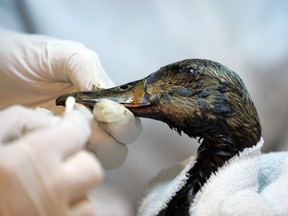
The sector has been working on plans for the reclamation of tailings sites — a process the industry says will require the release of wastewater into the Athabasca River. Unlike other mining and industrial operations in the country, oilsands operators have not been permitted to release treated water and volumes have been building for decades — now in the range of 1.4 trillion litres.
“We’re very much in alignment in wanting to protect the downstream environment and protect the Peace-Athabasca Delta and obviously, the Wood Buffalo National Park,” Rodney Guest, Suncor Energy Inc.’s director of water and closure, told reporters last week during a briefing hosted by the Mining Association of Canada.
“When we talk about designing these (tailings) facilities and doing the integrated water management, across the board it takes into consideration the nature and the need to protect these valuable, beautiful areas for those uses.”
Water used in the oilsands is recycled again and again before it is eventually stored in tailings facilities. Tailings are the sand, silt, clay and water separated from the bitumen during processing — a highly toxic mix that includes residual hydrocarbons, salts, organic compounds and metals — stored in engineered dams or dykes constructed above ground or in mined-out pits.
The sight of tailings ponds in northern Alberta will be familiar to most Canadians, associated with headlines decrying the migratory birds that die each year from landing on the ponds. The tailings themselves — captured in stark, iconic images by the likes of famed Canadian photographer Edward Burtynsky — have arguably taken on outsized symbolic significance, as they have become emblematic of the industry.

A duck gets its bill cleaned after landing in a tailings pond in 2008.
PHOTO BY JORDAN VERLAGE/SPECIAL TO THE SUN
Some reclamation of tailings sites has already occurred and several large field pilots are underway. But industry says it will be necessary for treated water to be released for reclamation to occur at a majority of tailings sites, and advocates insist there are proven methods for doing so safely, including chemical treatment techniques, sedimentation and flotation processes, and filtration.
Responses from environmental and Indigenous groups to these assurances range from skepticism to outright opposition.
Indigenous communities in northern Alberta were already concerned with the proximity of tailings ponds to the Athabasca River, alarmed over evidence of infiltration into groundwater, and concerned about the impact of other upstream developments such as British Columbia’s Site C hydro dam project. Communities such as the Mikisew Cree First Nation and the Athabasca Chipewyan First Nation (ACFN) have been meeting with UN monitors this week, and Indigenous leaders say they want to be consulted before any treated tailings are released into the Athabasca River.
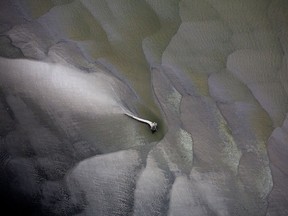
Some reclamation of tailings sites has already occurred and several large field pilots are underway. But industry says it will be necessary for treated water to be released for reclamation to occur at a majority of tailings sites, and advocates insist there are proven methods for doing so safely, including chemical treatment techniques, sedimentation and flotation processes, and filtration.
Responses from environmental and Indigenous groups to these assurances range from skepticism to outright opposition.
Indigenous communities in northern Alberta were already concerned with the proximity of tailings ponds to the Athabasca River, alarmed over evidence of infiltration into groundwater, and concerned about the impact of other upstream developments such as British Columbia’s Site C hydro dam project. Communities such as the Mikisew Cree First Nation and the Athabasca Chipewyan First Nation (ACFN) have been meeting with UN monitors this week, and Indigenous leaders say they want to be consulted before any treated tailings are released into the Athabasca River.

A log lays in a tailings pond at the Suncor oilsands operations
in Fort McMurray, in 2014.
PHOTO BY TODD KOROL/REUTERS FILES
“We’re basically in jeopardy of losing our ecological system,” said ACFN Chief Allan Adam. “There’s a lot people downstream that are not too happy about what is happening today and they’re going to voice their opinion and they’re going to make sure that their concerns are heard loud and clear.”
Oilsands companies say the sector is ready to deploy water treatment technologies; they just need to see new regulatory requirements, which are expected in 2025. The industry believes it is both technically and economically possible to process tailings water for release back into the environment.
“We’ve done lots of testing to know that we can treat the water and get the chemistry into the acceptable range for aquatic organisms and the environment,” Suncor’s Guest said.
“We’re basically in jeopardy of losing our ecological system,” said ACFN Chief Allan Adam. “There’s a lot people downstream that are not too happy about what is happening today and they’re going to voice their opinion and they’re going to make sure that their concerns are heard loud and clear.”
Oilsands companies say the sector is ready to deploy water treatment technologies; they just need to see new regulatory requirements, which are expected in 2025. The industry believes it is both technically and economically possible to process tailings water for release back into the environment.
“We’ve done lots of testing to know that we can treat the water and get the chemistry into the acceptable range for aquatic organisms and the environment,” Suncor’s Guest said.
We're basically in jeopardy of losing our ecological systemALLAN ADAM, ACFN CHIEF
Total water volumes currently stored in tailings ponds are equal to about two per cent of the annual flow of the Athabasca River. Industry officials say treated water volumes would be released slowly, over many years. The sector has not released a dollar figure for the cost of treating and releasing tailings water, but Guest suggested that it would be “substantial.”
Despite the efforts underway to draft regulations for the release of tailings water, Environment Minister Steven Guilbeault recently made clear in public comments that releasing oilsands wastewater isn’t the only option and Ottawa will be looking at other solutions, including recycling it back into operations or injecting the water underground.
Guilbeault also said last week that treated water would have to be drinkable in order to be released into the Athabasca — a comment that was poorly received by several industry experts, who said no other mining or heavy industry is required to meet such a standard.
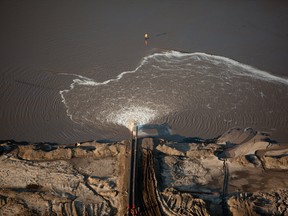
An aerial view of a tailings pond near Fort McMurray.
PHOTO BY RYAN JACKSON/EDMONTON JOURNAL
“Nowhere in Canada, nowhere in North America, do we do a direct reuse of industrial wastewater for drinking water purposes,” Guest said. “We do not treat industrial wastewater and then turn around and put it in a pipeline and pipe it into somebody’s home.”
Oilpatch veteran Greg Stringham acknowledged the debate around the disposal of oilsands wastewater and the reclamation of tailings sites has been politicized.
“Lots of other industries have materials that they need to deal with on a waste basis and this one seems to attract a lot of attention — but rightfully so, there’s a lot of it, so it needs to be done correctly,” said Stringham, former vice-president of the Canadian Association of Petroleum Producers.
“Nowhere in Canada, nowhere in North America, do we do a direct reuse of industrial wastewater for drinking water purposes,” Guest said. “We do not treat industrial wastewater and then turn around and put it in a pipeline and pipe it into somebody’s home.”
Oilpatch veteran Greg Stringham acknowledged the debate around the disposal of oilsands wastewater and the reclamation of tailings sites has been politicized.
“Lots of other industries have materials that they need to deal with on a waste basis and this one seems to attract a lot of attention — but rightfully so, there’s a lot of it, so it needs to be done correctly,” said Stringham, former vice-president of the Canadian Association of Petroleum Producers.
The ultimate goal needs to be long-term sustainability and water quality that is equal to or above what's in the environment around itGREG STRINGHAM
“I’m not going to put blame on either side. I’m just saying that the ultimate goal needs to be long-term sustainability and water quality that is equal to or above what’s in the environment around it.”
But Indigenous communities say existing regulations haven’t done enough to protect the Peace-Athabasca Delta and they’re worried about the consequences of releasing the tailings.\
One regulatory problem, according to an independent report commissioned by the Mikisew Cree, is the province’s weak mechanism for ensuring adequate funds are in place for the reclamation and remediation of mines.
The total estimated environmental liabilities of Alberta’s mines officially climbed above $33 billion in June 2021, although some sources have pegged the liabilities for the oilsands alone at $130 billion. Regardless, the regulator’s rules have allowed companies to set aside only $1.5 billion for cleanup under the Mine Financial Security Program. Critics say recent changes have weakened the rules further by allowing companies to provide financial surety in the form of a “surety bond” rather than cash, something experts say amounts to a promise that the company will have the money when the time comes for cleanup.
Alberta’s own auditor general has warned that the rules won’t protect taxpayers from being liable in the event of a broad decline in the oilsands sector — an eventuality that can’t be discounted amid declining investment in fossil fuels due to climate concerns.
“We absolutely don’t support the treatment and release of oilsands process water, including tailings. We don’t have any confidence in it,” Lepine said. “We’re relying on really broken, weak regulatory systems already in place that are causing these impacts and allowing these impacts to continue. So we don’t have any trust, we don’t have any confidence that they can do this.”
No comments:
Post a Comment